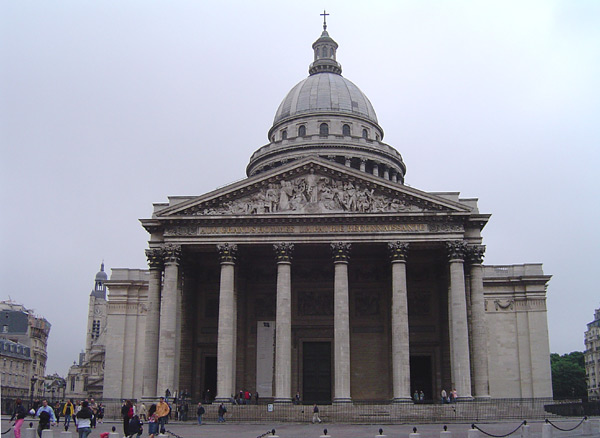Jacques-Germain Soufflot on:
[Wikipedia]
[Google]
[Amazon]
Jacques-Germain Soufflot (, 22 July 1713 – 29 August 1780) was a French
 The Panthéon is his most famous work, but the Hôtel Marigny built for his young patron (1768–1771) across from the Élysée Palace, is a better definition of Soufflot's personal taste. Soufflot died in Paris in 1780, and is buried in the Panthéon next to
The Panthéon is his most famous work, but the Hôtel Marigny built for his young patron (1768–1771) across from the Élysée Palace, is a better definition of Soufflot's personal taste. Soufflot died in Paris in 1780, and is buried in the Panthéon next to
architect
An architect is a person who plans, designs and oversees the construction of buildings. To practice architecture means to provide services in connection with the design of buildings and the space within the site surrounding the buildings that h ...
in the international circle that introduced neoclassicism. His most famous work is the Panthéon
The Panthéon (, from the Classical Greek word , , ' empleto all the gods') is a monument in the 5th arrondissement of Paris, France. It stands in the Latin Quarter, atop the , in the centre of the , which was named after it. The edifice was b ...
in Paris
Paris () is the Capital city, capital and List of communes in France with over 20,000 inhabitants, most populous city of France, with an estimated population of 2,165,423 residents in 2019 in an area of more than 105 km² (41 sq mi), ma ...
, built from 1755 onwards, originally as a church dedicated to Saint Genevieve.
Biography
Soufflot was born inIrancy
Irancy () is a commune in the Yonne department in Bourgogne-Franche-Comté in north-central France. It is located southwest of Chablis in Bourgogne-Franche-Comté.
History
The town of Irancy was developed beginning in the year 900AD when the Abb ...
, near Auxerre
Auxerre ( , ) is the capital of the Yonne department and the fourth-largest city in Burgundy. Auxerre's population today is about 35,000; the urban area (''aire d'attraction'') comprises roughly 113,000 inhabitants. Residents of Auxerre are r ...
. In the 1730s he attended the French Academy in Rome
The French Academy in Rome (french: Académie de France à Rome) is an Academy located in the Villa Medici, within the Villa Borghese, on the Pincio (Pincian Hill) in Rome, Italy.
History
The Academy was founded at the Palazzo Capranica in ...
, where young French students in the 1750s would later produce the first full-blown generation of Neoclassical designers. Soufflot's models were less the picturesque Baroque being built in modern Rome, as much as the picturesque aspects of monuments of antiquity.
After returning to France, Soufflot practiced in Lyon
Lyon,, ; Occitan language, Occitan: ''Lion'', hist. ''Lionés'' also spelled in English as Lyons, is the List of communes in France with over 20,000 inhabitants, third-largest city and Urban area (France), second-largest metropolitan area of F ...
, where he built the ''Hôtel-Dieu'', like a chaste riverside street facade, interrupted by the central former chapel, its squared dome with illusionistic diminishing coffers on the interior. With the Temple du Change, he was entrusted with completely recasting a 16th-century market exchange building housing a meeting space housed above a loggia. Soufflot's newly made loggia is an unusually severe arcading tightly bound between flat Doric pilasters, with emphatic horizontal lines. He was accepted into the Lyon Academy.
A more creative trip to Italy was made when the mature Soufflot returned in 1750 in the company of the future Marquis de Marigny, the talented young brother of Madame de Pompadour, who was being groomed for his future as director of the King's Buildings (''Bâtiments du Roi
The Bâtiments du Roi (, "King's Buildings") was a division of the Maison du Roi ("King's Household") in France under the Ancien Régime. It was responsible for building works at the King's residences in and around Paris.
History
The Bâtiments ...
''). On this trip Soufflot made a special study of theaters. In 1755 Marigny, the new Director General of Royal Buildings, gave Soufflot architectural control of all the royal buildings in Paris. In the same year, he was admitted to the Royal Academy of Architecture. In 1756 his opera house
An opera house is a theatre building used for performances of opera. It usually includes a stage, an orchestra pit, audience seating, and backstage facilities for costumes and building sets.
While some venues are constructed specifically fo ...
opened in Lyon.
 The Panthéon is his most famous work, but the Hôtel Marigny built for his young patron (1768–1771) across from the Élysée Palace, is a better definition of Soufflot's personal taste. Soufflot died in Paris in 1780, and is buried in the Panthéon next to
The Panthéon is his most famous work, but the Hôtel Marigny built for his young patron (1768–1771) across from the Élysée Palace, is a better definition of Soufflot's personal taste. Soufflot died in Paris in 1780, and is buried in the Panthéon next to Voltaire
François-Marie Arouet (; 21 November 169430 May 1778) was a French Enlightenment writer, historian, and philosopher. Known by his ''nom de plume'' M. de Voltaire (; also ; ), he was famous for his wit, and his criticism of Christianity—es ...
.
Like all the architects of his day, Soufflot considered the classical idiom essential. He stood out for his "strictness of line, firmness of form, simplicity of contour, and rigorously architectonic conception of detail"Sharp, Dennis (1991). ''The Illustrated Encyclopedia of Architects and Architecture'', p. 145. New York: Whitney Library of Design. . which contrasted sharply with the late Baroque and Rococo architecture of his contemporaries.
References
External links
* * {{DEFAULTSORT:Soufflot, Jacques-Gabriel 1713 births 1780 deaths People from Yonne 18th-century French architects Burials at the Panthéon, Paris French neoclassical architects Members of the Académie royale d'architecture